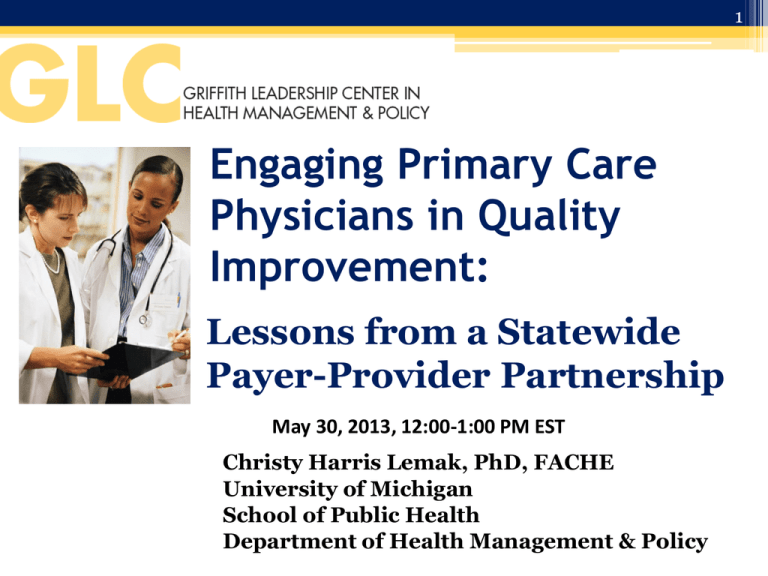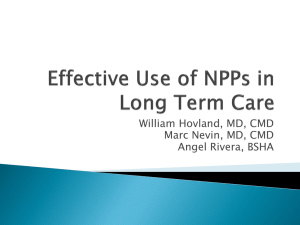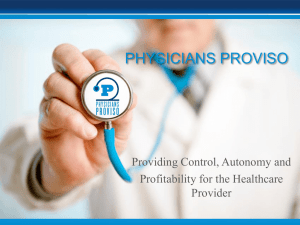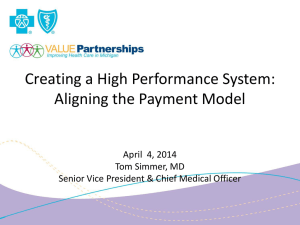PGIP - University of Michigan School of Public Health
advertisement

1 Engaging Primary Care Physicians in Quality Improvement: Lessons from a Statewide Payer-Provider Partnership May 30, 2013, 12:00-1:00 PM EST Christy Harris Lemak, PhD, FACHE University of Michigan School of Public Health Department of Health Management & Policy 2 The Griffith Leadership Center (GLC) cultivates exceptional leaders who will transform health and healthcare for a changing world. The Center works to strengthen and catalyze connections among research, teaching, and practice in health management and policy. The GLC’s Mission is to promote and support excellence in health management and policy leaders by strengthening the connections among research, teaching and practice. http://www.sph.umich.edu/glc/ 3 Today’s Learning Objectives Describe how a P4P program improved care processes in primary care practices. Identify ways to successfully implement physician practice improvement initiatives. Understand that improvement for physicians involves changes in philosophy as well as practice. 4 Agenda • Background • Evaluation Design • Findings • Drivers of Successful Provider Engagement • Practice Changes • Lessons Learned • Bibliography 5 Study Authors Christy Harris Lemak, PhD FACHE is the lead investigator of a Commonwealth Fund evaluation of the program described. She is an Associate Professor of Health Management & Policy at the University of Michigan and Director of the Griffith Leadership Center. She teaches management and leadership and serves as Chief Academic Officer of the National Center for Healthcare Leadership. Christy earned her MHA/MBA from the University of Missouri-Columbia and her PhD from the University of Michigan. Genna R. Cohen is a PhD student and Natalie Erb is a 2013 MPH graduate of the University of Michigan. 6 The Research Presented Was previously presented at the American College of Healthcare Executives (ACHE)’s 2013 Congress. Has been accepted for publication and will appear this fall in ACHE’s Journal of Healthcare Management 7 The Research Team Evaluation of the Physician Group Incentive Program: From Partisanship to Partnership From the University of Michigan: From BCBSM: • Christy Harris Lemak, PhD • David Share, MD/MPH • Genna R. Cohen • Darlene K. El Reda, DrPH • Natalie Erb, MPH • Mike Paustian, PhD • Jeff Alexander, PhD • Margaret Mason, MHSA • Richard Hirth, PhD • Andrew Billi • Tammie Nahra, PhD Funding Provided by the Commonwealth Fund 8 Background • Aligning the goals and interests of payers, providers, and patients • Central for population health improvements and efficiency (ACO approaches) • Prior research: • • • • • Practice infrastructure Organizational factors and clinician characteristics Physician participation and buy-in Clarity of program features Demonstration of success in local efforts 9 The Physician Group Incentive Program (PGIP) • Began in 2005, partnership of medical community and Blue Cross and Blue Shield of Michigan (BCBSM) • 40 physician organizations, 17,000 physicians, and 1.8 million members • Incentive Payments for: • Evidence-based care processes • Population-based cost measures • Participation in efforts to build infrastructure related to Patient Centered Medical Home • Others 10 PGIP: Key Statistics http://www.bcbsm.com/providers/valuepartnerships/value-partnerships-overview.html Source: BCBSM http://www.bcbsm.com/providers/valuepartnerships/value-partnerships-overview.html 11 What is PGIP? Focus: Initiatives - Various initiatives to improve process and outcomes of care PCMH Designation Program - Annual designation based on reporting on domains of function Support for Care Management – T-Codes (non-physician providers can be reimbursed) Collaborative Projects – e.g., Lean Thinking Clinic, Reengineering Collaborative Quality Initiative, others Payments To: Physician Organization Physician Practice Unit Physician Practice Unit Collaborative and/or Physician Organization 12 PGIP Initiatives Clinical information technologyfocused initiatives Accelerating the Adoption and Use of Electronic Prescribing Patient Portal* Patient Registry* Condition-focused initiatives Cardiac Care — Phase I Cardiac Care — Phase II Cardiac Care — Phase III Encouraging Evidence-Based Utilization of Hysterectomy Encouraging Evidence-Based Utilization of Labor Induction Environmental Cancer Michigan Oncology Quality Consortium Michigan Oncology Clinical Treatment Pathways Michigan Urological Surgery Improvement Collaborative Core clinical process-focused initiatives Evidence Based Care Tracking Initiative Lean for Clinical Redesign Michigan Transitions of Care Collaborative Coordination of Care* Extended Access* Individual Care Management* Linkage to Community Services* Patient Provider Partnership* Performance Reporting* Preventive Services* Self-Management Support* Specialist Referral Process* Test Tracking and Follow-Up* Service-focused initiatives Advance Care Planning Emergency Department Utilization Increasing the Use of Generic Drugs Michigan Anticoagulation Quality Improvement Initiative Radiology Management Organized systems of care initiatives Integrated Patient Registry Integrated Performance Measurement Processes of Care 13 BCBSM PCMH Efforts • Patient Centered Medical Home (PCMH) program: • ~5,600 primary care physicians and ~2,000 specialists • 2011 BCBSM PCMH Designation: • Over 2,500 primary care physicians and specialists in more than 770 practice units • Over $25M in annual E&M uplifts for PCMH designated providers Source: BCBSM Early Internal Studies Show Positive Program Results • Generic Prescribing Rate - 38% (’04) to 74% (’11) • Lower rates of hospitalization, radiology utilization and ED visits • Direct Radiology - $24M savings in 2010 • Cost trend fell to 1.9% with negative trend for professional costs (lower than any other Blues plan in the country) Source: BCBSM Internal Studies 15 Evaluation Questions & Methods Research Question What is PGIP? How was it developed and what have been its progress, accomplishments, and first-level impacts? Methods • • • To what extent have physician organizations participating in PGIP changed their organizational structures and systems of care to align with PGIP initiatives and • objectives? • • How have PGIP initiatives affected provider attitudes and perceptions regarding practice transformation, costs, and quality? What has been the impact of PGIP on • relationships among physicians and payers • in Michigan? What has been the impact of PGIP on utilization, costs, and quality? • Stakeholder Interviews Environmental Data Analyses PGIP Data Analyses PGIP Data Analyses PO & Physician Data Analyses Stakeholder Interviews Stakeholder Interviews Environmental Data Analyses PGIP Data Analyses 16 Key Informant Interviews (2011-12) BCBSM Other Payers Total Sites Total Individuals 1 8 2 3 Employers/Purchasers Other Stakeholders Physician Organizations 3 5 11 5 9 25 Physician Practice Sites 35 58 46 sites 83 people Total Themes/Analysis Table/coding/Atlas.ti queries 17 Overall Findings • • • • Physicians positive about the program PGIP perceived as supporting primary care Physicians valued the collaborative approach Physicians energized to improve their practice, become PCMHs and improve health of patients How? Why? 18 Five Drivers of Successful Provider Engagement in Quality Improvement 1. Vision of Improving Primary Care 2. Deliberately Fostering Practice-Practice Partnerships 3. Utilizing Existing Infrastructure 4. Leveraging Resources & Market Share 5. Managing Program Tradeoffs 19 (1) Vision for Improving Primary Care • PGIP intentionally designed to support primary care • Physicians believed the program was about this and not simply about saving money “The biggest catalyst for practice transformation is creating a different culture. Registries are great, and principles are great, but implementation of PCMH through PGIP gave it a meaning. This helps people understand not only individual parts, but also the whole vision.” 20 (2) Deliberately Fostering Collaboration • BCBSM developed communities of practice “They want to know what the physician community thinks. They work with us, versus other companies who just tell us what their program is and what to do.” “There’s always someone who you can learn from.” “Collaboration with other practices has been the most helpful aspect of PGIP.” “We’re all moving in the same direction and we’re helping each other get there.” 21 (3) Working with Existing Infrastructure • BCBSM worked with existing physician organizations to implement the program. “PGIP works because of the physician organization (PO) model. These doctors together have the resources. The onesies and twosies who don’t play in this will not make it.” 22 (4) Leveraging Resources • BCBSM market position helped secure physicians’ attention and made the program financially worthwhile. “It is very hard to change physician behavior to “do the right thing” …when there is money backing up the guidelines, the money gives us a tool to help position practices in the direction we want to go.” 23 (5) Proactively Managing Trade-offs • Flexibility and responsiveness meant a complex, ever-changing program. “Blue Cross asks us for ideas and is willing to implement them….but sometimes it feels like the program is always changing (as new initiatives are implemented)” 24 Impact on Physician Practices • PGIP was associated with practical changes in: • Staff and Workflow • Adoption of health information technology • Use of LEAN Process Engineering “…the whole practice is involved - even my billers know when someone’s A1c level is too high…” 25 Impact on Physician Practices • PGIP inspired philosophical changes • Population-focused model for clinical improvements • Improvement approach (rather than just performance) “I used to think I was the best primary care physician anywhere. With the patient registry, now I know I’m not and I am working to improve.” 26 Lessons Learned & Opportunities to Improve • • • • Data Program Design Structural Shortcomings Calls for Evaluation & Transparency “They tell us it works, but it’s time to show us the results” 27 Summary: Successful Strategies Strategy: Specific Example(s): Entire program focused on bolstering primary care, with consistent messaging and reinforcement. Deliberately Fostering Support (financially and structurally) Practice-Practice communities of practice, connecting individuals Partnerships with common interests. Utilizing Existing Existing intermediary organizations support Infrastructure communication and physician integration. Vision of Improving Primary Care Leveraging Resources Focus on areas with significant market share first. and Market Share Put money on the table early. Managing Program Tradeoffs Develop flexible learning organizations with robust communication as program elements evolve. 28 Questions? 29 Bibliography 1. Alexander, J., G. Cohen, et al. (2012). "The Policy Context of Patient Centered Medical Homes: Perspectives of Primary Care Providers." Journal of General Internal Medicine: 1-7. 2. Bitton, A., G. R. Schwartz, et al. (2012). "Off the Hamster Wheel? Qualitative Evaluation of a Payment-Linked Patient-Centered Medical Home (PCMH) Pilot." Milbank Quarterly 90(3): 484515. 3. Cohen, G. R., N. Erb, et al. (2012). "Physician Practice Responses to Financial Incentive Programs: Exploring the Concept of Implementation Mechanisms." Advances in Health Care Management 13: 29-58. 4. Goldberg, D. G., S. S. Mick, et al. (2012). "Why Do Some Primary Care Practices Engage in Practice Improvement Efforts Whereas Others Do Not?" Health Services Research: n/a-n/a. 5. Kreindler, S. A., B. K. Larson, et al. (2012). "Interpretations of Integration in Early Accountable Care Organizations." Milbank Quarterly 90(3): 457-483. 6. Share, D. A., D. A. Campbell, et al. (2011). "How A Regional Collaborative Of Hospitals And Physicians In Michigan Cut Costs And Improved The Quality Of Care." Health Affairs 30(4): 636645. 7. Share, D. A. and M. H. Mason (2012). "Michigan’s Physician Group Incentive Program Offers A Regional Model For Incremental ‘Fee For Value’ Payment Reform." Health Affairs 31(9): 19932001. 8. Wise, C. G., J. A. Alexander, et al. (2012). "Physician Organization-Practice Team Integration for the Advancement of Patient-Centered Care." Journal of Ambulatory Care Management 35(4): 312-323. 30 Contact Information Christy Harris Lemak, PhD FACHE Director, Griffith Leadership Center Associate Professor, Health Management and Policy School of Public Health Associate Professor, Surgery University of Michigan Chief Academic Officer, National Center for Healthcare Leadership 734-936-1311 chrislem@umich.edu






